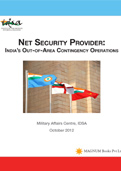You are here
Net Security Provider: India’s Out-of-Area Contingency Operations

Related Pages
- Book review in USI Journal
- Book review in Aakrosh
- Book review by Defence Watch
- Book review by Defence and Technology Journal
- Event report of book release by Lt. Gen. N.C. Marwah PVSM, AVSM, CISC
- PM's speech at the foundation stone laying ceremony for the Indian National Defence University at Gurgaon
- Key Speech by Chief of the Naval Staff (CNS), Admiral D K Joshi, PVSM, AVSM, YSM, NM, VSM, ADC
About the Book
India’s economic growth and prosperity are increasingly being shaped by circumstances outside its borders. Most prominently, trade and access to energy are now critical components of the Indian economy. In addition, the Indian diaspora, which is a source of significant remittances, also needs protection and evacuation. Thus, India’s economic and national interests are gradually spreading outwards from its borders. Also, at times, the Indian military has been deployed for security operations – for instance, in anti-piracy operations off the coast of Somalia and in overseas humanitarian and disaster relief operations. In light of its capabilities and possible overseas role, the Indian military has been called a ‘net security provider’ in the region. This report, therefore, focuses on examining the Indian military’s Out-of-Area Contingency (OOAC) operations.
In examining this topic, the report analyses previous deployments of the Indian military outside its borders, including in United Nations Peacekeeping Operations (UNPKO), evacuation of Indian citizens from conflict zones and in active operations like Sri Lanka from 1987–90 and the Maldives in 1988. It then examines the current capacity and trends for executing such operations. Finally, it makes recommendations not only for the Armed Forces but for other relevant agencies as well, such as the Ministries of Defence and External Affairs, the National Security Council and the Cabinet Secretariat.
A summary of the discussion that took place on the occasion of the release of this report is available here
Contents
Preface
Executive Summary
Chapter 1: The Case for Out-of-Area Contingency Operations
Section I: Conduct of Previous Out-of-Area Contingency Operations
Chapter 2: UN Peacekeeping Operations: Leveraging India’s Forte
Chapter 3: Non-Combatant Evacuation Operations
Chapter 4: Overseas Humanitarian and Disaster Relief Operations
Chapter 5: Major Lessons from Operation Pawan (Sri Lanka, 1987–90) and Operation Cactus (Maldives, 1988)
Section II: Current Issues in Planning for Out-of-Area Contingencies
Chapter 6: Existing Capacity and Future Planning for Out-of-Area Contingencies
Chapter 7: Role of Ministry of External Affairs in Out-of-Area Contingency Operations
Chapter 8: Strategic Communication and Perception Management for Out-of-Area-Contingency Operations
Chapter 9: Conclusions
Appendices
Seminar Participants and Discussants
Project Contributors
Col. (retd.) Ali Ahmed was formerly Research Fellow at IDSA. He is currently Assistant Professor at Jamia Millia Islamia, New Delhi.
Dr. Laxman Behera is Research Fellow at IDSA, New Delhi.
Col. (retd.) Vivek Chadha is Research Fellow at IDSA, New Delhi.
Brig. (retd.) Rumel Dahiya, SM is Deputy Director at the Institute for Defence Studies and Analyses (IDSA), New Delhi.
Col. (retd.) P.K. Gautam is Research Fellow at IDSA, New Delhi.
Col. Venu Gopal is Research Fellow at IDSA, New Delhi.
Shivananda H. was formerly a Research Assistant at IDSA. He is now with the National Security Council Secretariat.
Dr. S. Kalyanaraman is Research Fellow at IDSA, New Delhi.
Gp. Capt. Vivek Kapur is Research Fellow at IDSA, New Delhi.
Mr. Amit Kumar is Research Assistant at IDSA, New Delhi.
Col. Virender Kumar was Research Fellow at IDSA, New Delhi.
Ms. Shruti Pandalai is Officer on Special Duty (Outreach) and Research Analyst at IDSA, New Delhi.
Cdr. S.S. Parmar is Research Fellow at IDSA, New Delhi.
Lt. Col. Mahendra Prasad is Research Fellow at IDSA, New Delhi.
Dr. Anit Mukherjee was the Coordinator of this project. A Research Fellow at IDSA till recently, he is now a Post-Doctoral Fellow at the Center for Advanced Study of India, University of Pennsylvania.
Order Hard Copy
Please email us at publication [at] idsa.in or call +91-11-2671 7983 (Ext. 7303)


